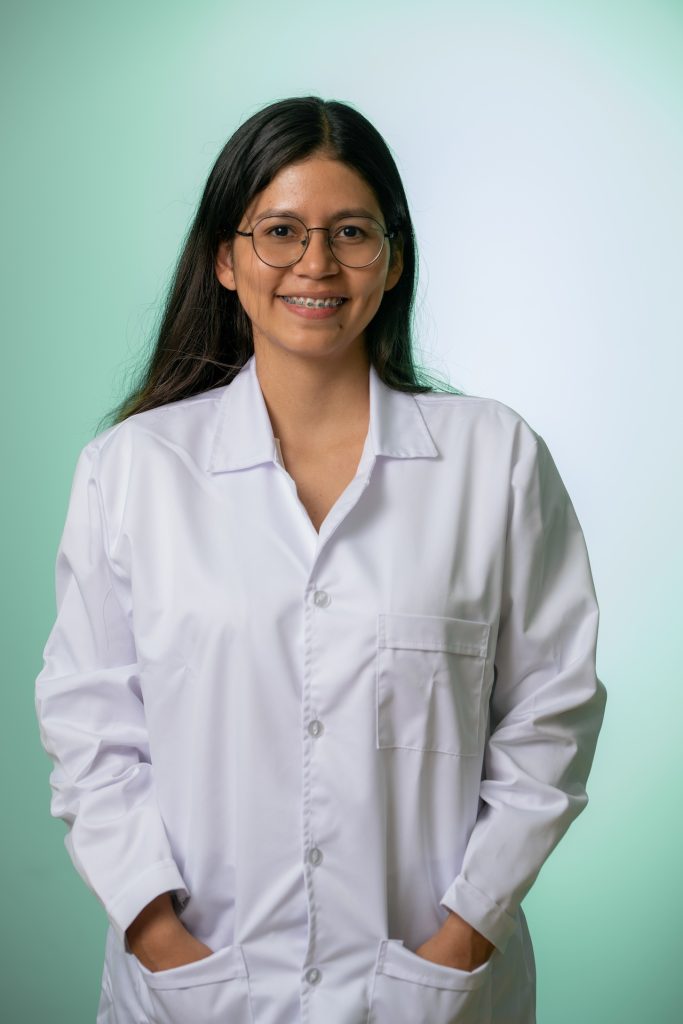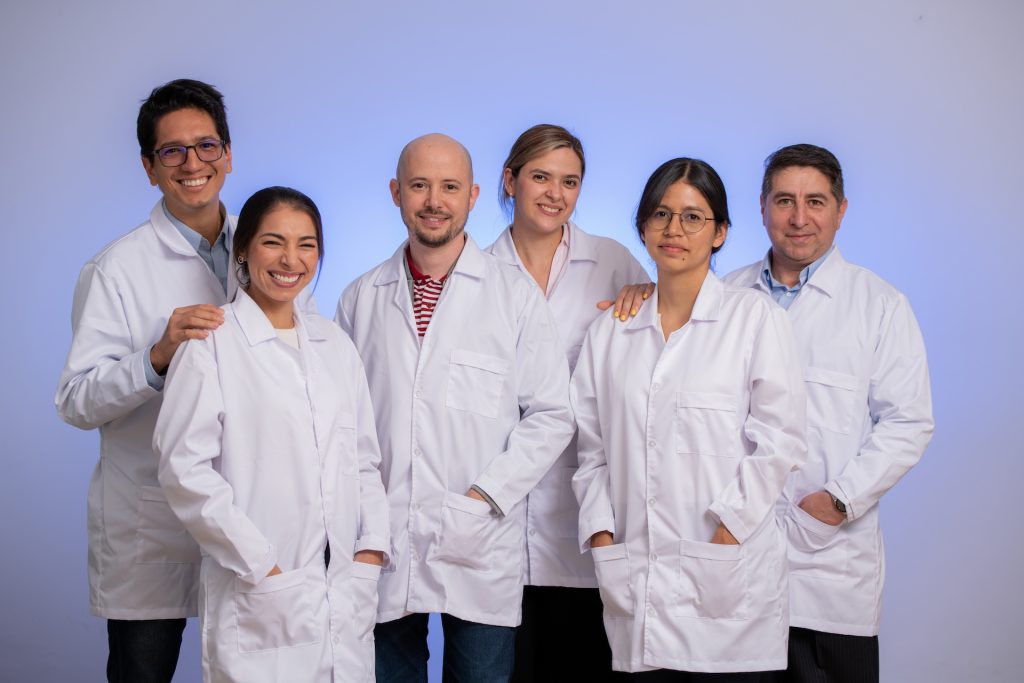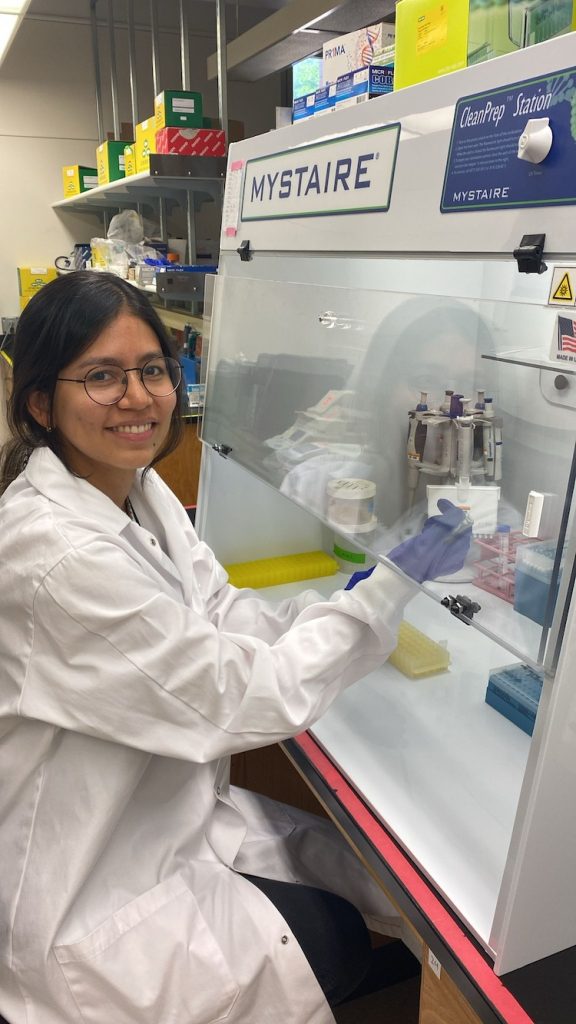
Maria Stella Lopez Carvajal in the Osorio Lab at UW–Madison (Photo from M. S. Lopez Carvajal)
By Katie Newcomb, GHI Communications Director…Maria Stella Lopez Carvajal has always looked at the world through a multidisciplinary lens. Even as a young girl in Colombia, where she loved biology, math, and chemistry, she could see all the possibilities to a situation or problem and knew the intersection of synergies were where solutions could be found. “One of my dreams when I was a child was to get enough knowledge to try to put together fields that people usually think of as different,” shared Lopez Carvajal. “I like to act like a link. That’s why I work in the field of artificial intelligence with biology and also incorporate engineering.”
To get her start harnessing her love of knowledge, Lopez Carvajal left her hometown of Bucaramanga when she was 17 years old to earn both her Bachelor’s Degree in Chemical Engineering (2019), and Master’s Degree in Analytical Engineering (2023), from Universidad Nacional de Colombia (UNAL), in Medellín. Like many, Lopez Carvajal found herself not only in the middle of her master’s program, but also in the middle of a global pandemic. This didn’t deter her-it actually motivated her even more to find a position to help advance her studies.

In 2021, Maria Stella Lopez Carvajal began working at VaxThera, the Colombian biotechnology company where GHI Director Jorge Osorio serves as CEO. Her work as a scientific researcher focuses on bioreactors to produce vaccines, which is at the heart of VaxThera’s mission: Developing products and services that contribute to Colombia and the region’s health sovereignty, positively impacting people’s health through prevention.

Lopez Carvajal (second right) in VaxThera research group (Photo from M.S. Lopez Carvajal)
To expand her knowledge while working on her master’s degree, Lopez Carvajal spent five months in Madison with Jorge Osorio’s lab in the School of Veterinary Medicine and Department of Pathobiological Sciences on various vaccine development projects in September 2021. Today, Carvajal continues at VaxThera, and is also harnessing her work and translating it into her PhD efforts (again with Osorio’s lab) to develop a second-generation yellow fever vaccine. Lopez Carvajal is able to move forward with this opportunity in part through funding from GHI and a grant from the Ministry of Science, Technology and Innovation of Colombia.
“When I first started in research and development at VaxThera, the other researchers and I had the opportunity to learn from Jorge’s experience. He was always available for advice on our formulations. And while in his lab, I learned a lot about procedures and was then able to take that knowledge back to Colombia,” Lopez Carvajal shared.
When discussing her current PhD work, Lopez Carvajal shares, “Data analytics is so useful for any field right now. I like connecting the field of machine learning with biology. The idea is, with artificial intelligence and bioinformatic tools, to design a mRNA vaccine that is going to have the best coverage of the current yellow fever strain.”

Lopez Carvajal anticipates her PhD project will take four years to complete. In the beginning, the thought was to split the time between UW–Madison and UNAL, but Lopez shares the richness of experience in Madison may change those plans. “In my PhD process, I have found there are so many people here with a lot of experience with whom I can reach out and collaborate on projects. That is something that isn’t as easy in Colombia. So, I like the idea to learn as much as I can and then transfer that knowledge for my country.”
And why is developing a second-generation yellow fever vaccine important? Yellow fever has seven genotypes and the existing vaccine, 17D, was created in 1938. While it has been highly effective, there have been recent cases with genotypes South American I and II where 17D is not working. The factors to this breakdown are multiple; some include the age of the current vaccine not covering new emerging variants, disrupted vaccination programs during the Covid pandemic leaving a larger portion of the population susceptible, and trying to break the sylvatic cycle of pathogen transmission since non-human primates are not vaccinated and highly susceptible to yellow fever. Lopez Carvajal wants to create a second-generation yellow fever vaccine to cover the gap with these current strains.
Her research focus is not on humans, but on non-human primates. Lopez Carvajal explains the connection between animals and humans is crucial when looking for solutions to mitigate the spread of the disease as it’s difficult to control with non-human primates. For example, when a mosquito bites an infected monkey, that mosquito is now a carrier and can infect other monkeys and possibly humans if humans travel to these more natural habitats. Once a person is infected and travels back home, that’s when an urban cycle of transmission takes over. Lopez Carvajal’s project is to develop the vaccine for testing. When it is ready for testing in the field, it will be placed in bait and spread in natural non-human primate habitats to help break the cycle of transmission.
Her goal is to formulate the correct mRNA vaccine candidate. Once developed and validated through invitro and invivo studies, Lopez Carvajal hopes to travel to the Amazon area, where multiple countries are affected by yellow fever, to implement field research. She notes Africa is also having a significant outbreak.

Shifting gears back to Madison, Lopez Carvajal shares some of her favorite things, including working in Jorge’s lab. “I really love working in the lab,” Lopez Carvajal said with a smile. “It is a familiar place with people from Colombia, Honduras, and more. But there are also Americans who are learning Spanish. So, it’s a great space to practice our languages and have a cultural exchange that is really nice. Plus, we all seek each other out for advice on our projects based on our experiences and knowledge,” she continued. “And Jorge is very encouraging to work with.” Another Madison favorite is the lakes. “I really like Madison’s lakes. I didn’t have that back in the city before I came here.” But she really lights up when talking about the people in Madison.
“As a child, I never thought I would be in a place where there are people from so many countries. I never imagined that! Sometimes I’m on the bus going home and look around and see people from all over the world and I think this is wonderful,” Lopez Carvajal beamed.
Just as GHI’s foundation is all about building connections, networks, ecosystems for global health security, Lopez Carvajal’s foundation is about building relationships. She notes even as a child with her brothers, she found herself in the role of a bridge builder. “I like the feeling of overcoming barriers and exploring something new to change the direction of things. One of my motivations in life is to help people. I’m not just doing research to get grants, it’s about changing your environment.”
To learn more about Lopez Carvajal’s research and efforts, reach out to her atmslopez3@wisc.edu.
